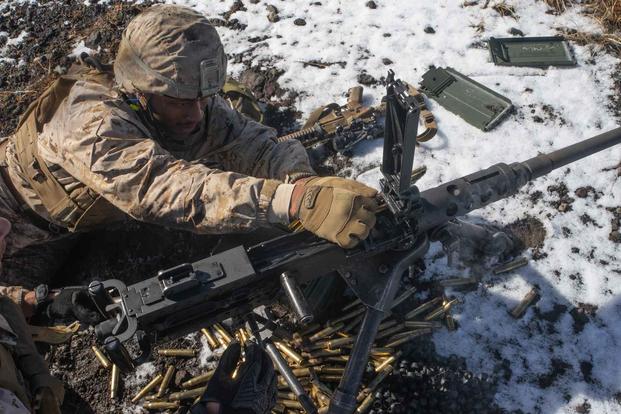The Marine Corps is looking to reduce the weight of its .50 caliber ammunition in an effort to increase speed and survivability for Marines on the battlefield.
On Sept. 26, Marine Corps Systems Command posted a request for information, or RFI, to potential vendors in providing lightweight .50 caliber ammunition. According to the RFI, the Corps is interested in a belt of 100 .50 caliber cartridges weighing 20.3 pounds to 22.3 pounds, which would offer a weight savings of 24% to 30%.
The command told Military.com that a "factory-packed box" consisting of two cans with 100 rounds each of .50 caliber ammunition currently weighs 77 pounds -- a significant load for troops to shoulder.
Read Next: Inside the Army's Mad Dash for Recruiters After Graduating Only Half the Number Needed
The Corps expects to deliver the lighter .50 caliber ammo to the fleet by the end of 2026, according to Ashley Calingo, a spokesperson for Marine Corps Systems Command, or SYSCOM.
The desire to reduce the .50 caliber ammo's weight is part of the Corps' continuing effort to lighten its infantry and increase speed on the battlefield.
"Agility and speed are critical to battlefield survivability, and we are continuously looking to reduce the weight of ammunition Marines must carry into the fight," Calingo told Military.com.
"This weight reduction will also reduce fuel consumption and other transportation costs, and may reduce weapon system maintenance costs," Calingo added.
In recent years, the Corps has sought to lessen combat loads on its grunts by reducing the weight of its body armor. The Marines have also experimented with robots to tackle the weight burden shouldered by grunts.
On Sept. 9, aboard the sprawling Marine training base at Twentynine Palms, California, troops test-ired an M72 anti-tank rocket with a small robot dog known as the Robotic Goat, according to a command release.
The service also started fielding its Plate Carrier Generation III in 2020, which is roughly 25% lighter than previous protective vests.
In 2019, then-Marine Corps Capt. Courtney Thompson won the Stephen A. Tisdale Thesis Award for her research on the importance of reducing weight to boost combat effectiveness and survivability on the battlefield, according to a press release.
Thompson's award-winning research titled,"Paying for Weight in Blood: An Analysis of Weight and Protection Level of a Combat Load During Tactical Operations," found that just 15 pounds could be the difference between life and death for a Marine on the battlefield.
Her research gained the attention of the Marine Corps Warfighting Lab and SYSCOM.
In another thesis on the dangers of excessive combat loads, published in 2020, she warned that military leaders should not just "limit themselves to the solution of lighter" protective gear.
"This problem requires a holistic approach, including reducing the gear carried for missions; scrutinizing what is mission-essential; examining currently fielded gear, such as radios, for weight reduction; and identifying weight as a critical technical parameter" when it comes to new Defense Department acquisitions, Thompson said in her research.
She found that combat loads carried by American troops in Iraq and Afghanistan reached 160 pounds, with an average load of 117 pounds.
Now a major with 3rd Marine Division in Okinawa, Japan, Thompson told Military.com that autonomous systems are an area of "great interest" for reducing the weight shouldered by Marines.
"I believe commanders never intend to overburden their Marines, since no one wants to carry things they don't need. But at the end of the day, if it's needed for the mission or personnel sustainment, you have to take it; that's why we train," Thompson added.
Calingo said that, following the RFI for the lighter .50 caliber ammo, a technical team will review industry responses.
"After assessing the likelihood that the vendor could manufacture the round, our team will make recommendations on whether to further evaluate the proposed solution via a follow-on contracting action," Calingo explained.
-- Shawn Snow is a freelance reporter and Marine veteran. He previously reported for Military Times covering the Marine Corps and overseas operations. He is on X @ShawnSnow184, and can be reached at shawnsnow184@yahoo.com.











